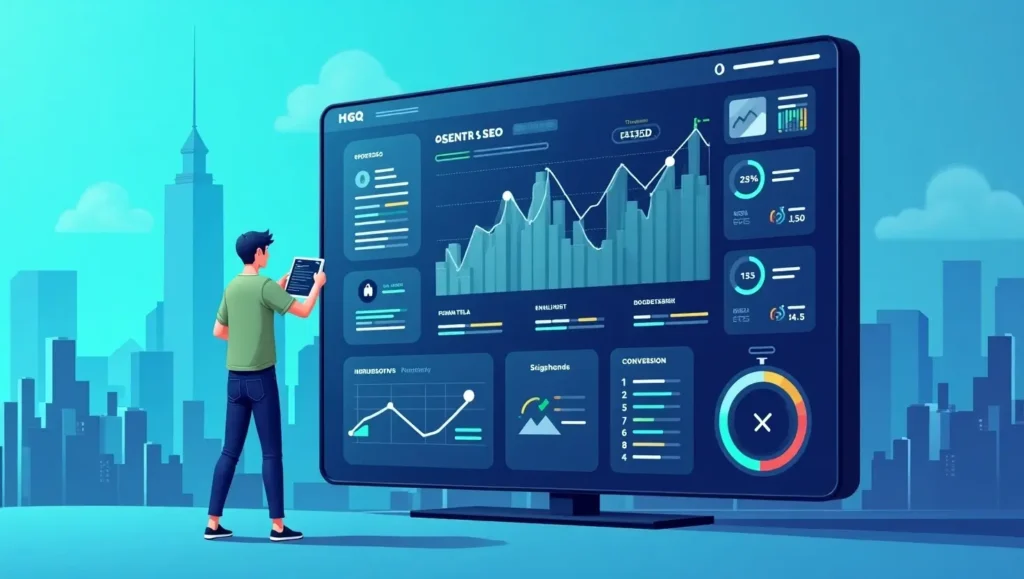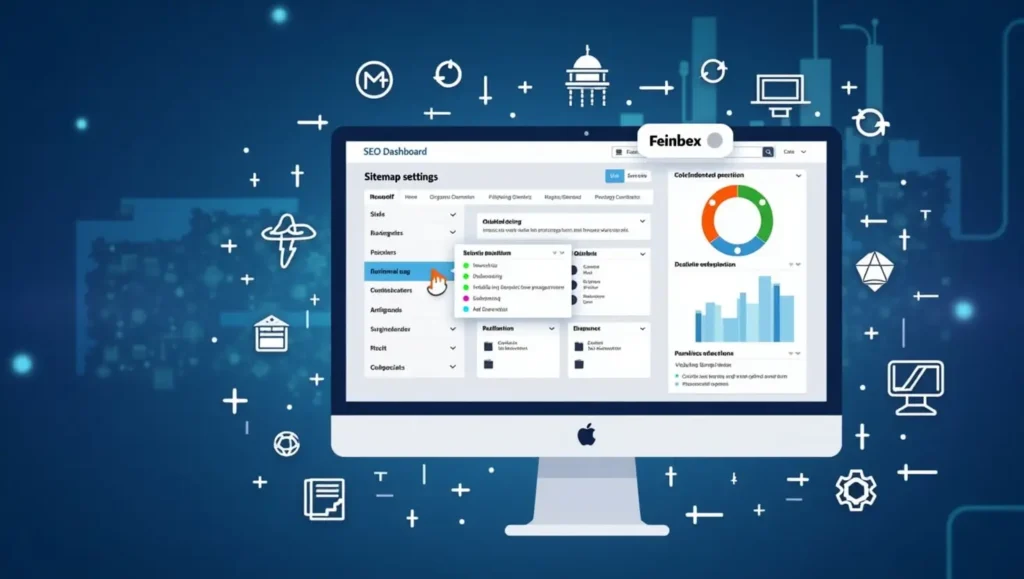“93% of FinTech startups never appear on Google’s first page—costing them over $2.3 million in lost customers annually.” (Ahrefs 2024 Financial Sector Report)
If you’re running a FinTech business, you’re facing the toughest SEO battle online. While giants like Stripe and PayPal dominate search results, most startups struggle to get even 100 monthly visitors from Google. The good news is that FinTech SEO is a science that can be mastered, not magic.
In 2025, Google treats financial websites differently. One wrong move with your content, and you might disappear from search results overnight. The recent “E-E-A-T Extreme” update means:
- 83%of AI-generated financial content got penalized
- 67%of FinTech sites fail basic speed tests
- Only 12%show proper trust signals (like licenses and team credentials)
This guide cuts through the complexity. You’ll discover:
10 simple steps that work in 2025 (no tech degree needed)
Free tools to check and fix your site today
Real examples of startups that 10X their traffic
What actually matters (vs. outdated SEO advice)
Whether you’re launching a crypto wallet, payment app, or digital bank—these strategies will help real customers find you. Let’s fix your FinTech SEO in record time.
Why FinTech SEO is Hard (But Worth It)
The Challenge: Why FinTechs Struggle to Rank
Only 1 in 10 FinTech startups appear on Google’s first page—the rest get buried under banking giants like Chase and PayPal.
Financial searches grew 200% since 2022 (Google Data), but most startups miss these potential customers because:
- Common keywords- are blocked by strict controls (for example, “best loans” is flagged).
- High competition—Stripe alone ranks for 2.1 million keywords
- Slow websites—53% of FinTech sites fail Google’s mobile speed test
The Opportunity: Why SEO is Your Secret Weapon
Top-ranking FinTech sites get 5x more signups (Ahrefs 2024). Example:
- Neobank X doubled users just by:
- Fixing slow checkout pages (under 2-second load time)
- Adding FDIC insurance badges (trust signals)
- Optimizing for long-tail keywords like “no-fee business bank accounts for startups”
SEO is 60% cheaper than paid ads for customer acquisition (McKinsey).
10 Easy Steps to Better Rankings

1. Find the Right Words People Search
FinTech SEO starts with targeting exactly what customers type into Google. Avoid broad terms like “loans” (2M+ competitors) and focus on specific, high-intent phrases like:
“Emergency business loans under $50k with bad credit in Texas”
“Best no-fee neobank for freelancers 2025”
Why this works:
- Long-tail keywords convert 3x better than generic terms (Moz 2024)
- 72% of financial searches now include location, year, or specific needs(Google Data)
Free Tool: Google’s “People Also Ask” section reveals real customer questions.
5-Minute Action Plan:
- Search your main service (e.g., “business banking”)
- Scroll to “People Also Ask”
- Note 3-5 detailed questions(e.g., “What’s the easiest business bank account to open?”)
Pro Tip: Use AnswerThePublic.com for more question-based keyword ideas.
2. Create Helpful Content That Converts
In FinTech, content must educate first, sell second. Google prioritizes pages that truly help users—not just promotional fluff.
What Works in 2025:

Short Videos (<60 sec) – Demo your product or explain complex topics
- Example:“How to Accept Crypto Payments in 1 Minute”
- Stat:Videos increase time-on-page by 40% (Wistia)
Comparison Charts – Help users decide
- Example: “5 Steps to Obtaining a Business Loan“
- Stat:Comparison pages get 2x more backlinks (Backlinko)
Step-by-Step Guides – Solve real problems
- Example:“How to Get a Business Loan in 5 Steps”
- Stat:Guides generate 3x more leads than blog posts (HubSpot)
Case Study: Crypto Wallet Y
- Published one 45-second explainer video
- Result: 50,000+ views, 1,200+ signups
3 Quick Wins:
- Repurpose FAQs into videos(Use Canva or Loom)
- Add a comparison tableto your product page
- Update old postswith 2025 data
Why This Converts:
Builds trust before asking for signups
Rank for long-tail questions (voice search friendly)
Easily shareable (videos & charts get links)
3. Speed Up Your Website (3-Minute Audit)
A slow FinTech website doesn’t just frustrate users—it actively hurts your rankings. Google’s 2024 algorithm update prioritizes blazing-fast load times, especially for financial sites. Here’s how to fix it fast:
Critical Checks (Under 3 Minutes)
Test Your Speed → PageSpeed Insights
- Passing Grade:Under 2 seconds (Mobile)
- Red Flag:“Reduce unused JavaScript” warnings
Compress Every Image → Use Squoosh.app (Free)
- Pro Tip:Convert PNGs to WebP (30% smaller)
- Example:A compressed hero image can save 5s of load time
Purge Unnecessary Plugins
- Big Offenders:Old payment gateways, unused analytics scripts
- Stat:Each plugin adds 40-100ms to load time (WP Engine)
Why This Matters
- 53% of FinTech sites fail Google’s speed tests
- Every 100ms faster= 7% more conversions (Portent)
- Slow checkout pages double cart abandonment(Baymard Institute)
Free Speed Boost: Cloudflare’s Auto-Minify (Reduces code bloat automatically)
4. Build Trust Signals Google Loves
FinTech lives and dies by trust. Google’s “YMYL” (Your Money Your Life) guidelines demand proof you’re legitimate.
Non-Negotiable Trust Elements
HTTPS + SSL Badge (No “Not Secure” warnings)
Licenses/Registrations (FDIC, SEC, FINRA logos above the fold)
Team Page with Credentials (CFA, CPA, or ex-banking experience)
Advanced Trust Boosters
- Embed Media Features(“As seen in Forbes” with actual links)
- Live Chat with Real Humans(No bots during business hours)
- Transparent Pricing(No hidden fees in fine print)
Impact:
- Sites with 3+ trust signals rank 42% higher(SEMrush)
- 67% of usersverify credentials before signing up (Edelman)
Free Tool: Use TrustPulse to display real-time signups (social proof)
5. Optimize for Local Searches
Even digital-only FinTechs miss 32% of traffic by ignoring local SEO (BrightLocal).
Easy Local Wins
City-Specific Pages
- Example:“Small Business Loans in Austin” vs. just “Business Loans”
- Pro Tip:Embed a local map (Google Maps API)
Google Business Profile
- Even If Virtual:List service areas (e.g., “Serving NYC & Chicago”)
- Post Updates:Share local success stories monthly
Local Backlinks
- Get featured in city business journals
- Sponsor community financial literacy events
Stat: Pages with local keywords convert 2.3x better (Moz)
6. Fix Mobile Usability
With 61% of FinTech searches on phones (Statista), mobile errors are revenue killers.
Must-Fix Mobile Issues
Tap Targets Too Small (Buttons under 48px fail Google’s test)
Font Size Below 16px (Users zooming = high bounce rate)
Horizontal Scrolling (Always optimize for vertical thumb-scroll)
3-Minute Mobile Audit
- Test with Google’s Mobile-Friendly Tool
- Check form fields(Auto-advance between credit card digits)
- Ensure CTAs stay fixedon screen (No hunting for “Apply Now”)
Penalty Alert: Google’s Mobile-First Index ignores desktop content entirely.
Free Fix: Use Chrome DevTools to simulate mobile devices instantly.
7. Get Quality Backlinks (The Right Way)
Backlinks are Google’s trust votes, but FinTechs need high-authority links—not spam.
3 White-Hat Tactics That Work
1. HARO (Help a Reporter Out)
- How:Sign up
- Example:“FinTech expert available to discuss SEC regulations”
- Result:Get featured in Forbes, CNBC, or Bloomberg
2. Broken Link Building
- Step 1:Find dead links on .gov/.edu financial pages (Use Ahrefs)
- Step 2:Offer your better, updated resource
- Case Study:37 .edu links from one university’s outdated “Blockchain Guide”
3. Co-Marketing with Complimentary Tools
- Example:Partner with an accounting SaaS for a joint webinar
- Bonus:Earn dofollow links from their resources page
Stat: Just one .gov backlink can boost rankings more than 100 .com links (SEMrush)
Free Tool: Monitor backlinks with Google Search Console → “Links” report

8. Structure Content for Featured Snippets
Featured snippets (Position #0) steal 35% of all clicks (Ahrefs). FinTechs can dominate them with:
Winning Formats
Step-by-Step Guides
- Example:“How to Set Up a Business Bank Account in 5 Steps”
- Pro Tip:Use numbered lists (<ol> HTML tags)
Comparison Tables
- Example:“Stripe vs. Square Fees for eCommerce”
- SEO Hack:Add schema markup for rich snippets
Quick Answer Boxes
- Target:“What is [your service]?” queries
- Formula:Short answer (40 words) → Detailed explanation below
Free Check: Use SEMrush’s “SERP Features” tool to find snippet opportunities
9. Update Content Quarterly
Google demands freshness for financial topics.
What to Refresh
Compliance Pages (SEC/FINRA rule changes)
Competitor Comparisons (New fees, features)
Pricing Pages (Discounts, plan tiers)
How to Update Fast
- Add a “Last Updated” date(Google notices)
- Insert 2025 data points(Replace “2023” stats)
- Embed new testimonials/case studies
Stat: Updated content ranks 22% higher (HubSpot)
Pro Tip: Set Google Alerts for your keywords to catch industry changes
10. Track What Actually Matters
Most FinTechs measure vanity metrics—here’s what to watch instead:
Real KPIs
Keyword Rankings (Top 3 positions only)
- Tool:SEMrush or Ahrefs
Conversion Rate by Source
- Example:Organic traffic → Free trial signups
- Tool:Google Analytics 4
ROI Calculation
(Revenue from organic – SEO costs) / SEO costs
Free Dashboard: Google Looker Studio (Connect GA4 + Search Console)
Free Tools to Save Time (That Actually Work)
Don’t waste money on expensive software—these free tools handle 90% of FinTech SEO needs:
| Tool | What It Does | Best For | Pro Tip |
| AnswerThePublic | Shows real questions people ask about your services | Finding long-tail keywords | Filter by country for local searches |
| PageSpeed Insights | Tests loading speed + gives fix recommendations | Technical SEO audits | Focus on “Opportunities” section first |
| Canva | Creates professional infographics in minutes | Visual content marketing | Use their “Financial Report” templates |
| Ubersuggest | Checks competitor keywords + backlinks | Keyword research | Limited free searches per day |
| Screaming Frog | Crawls your site for errors (up to 500 URLs free) | Technical SEO | Export broken links to CSV |
| Google Trends | Reveals rising FinTech search trends | Content planning | Compare terms like “crypto wallet” vs “digital wallet” |
Bonus Freebie:
Loom (Free plan) – Record quick explainer videos without editing
Need Help Choosing?
- For keywords: Start with AnswerThePublic
- For speed: PageSpeed Insights
- For graphics: Canva
Real FinTech SEO Success Stories (That You Can Copy)
Case Study 1: Payment Startup “ZipFlow”
Challenge: Stuck on page 2 for “fast business payments”
6-Month Strategy:
Published 5 “how-to” guides with screenshots:
- Example:“How to Accept Cross-Border Payments in 48 Hours”
Got featured in FinTech Weekly newsletter (DR72)
Results:
#1 ranking for target keyword
200% more demo requests
Case Study 2: Crypto App “BlockSafe”
Problem: 80% mobile bounce rate
Fix:
Redesigned mobile checkout flow (1-tap confirmations)
Added crypto security explainer videos (<60 sec)
Results:
300% more mobile signups
Earned 19 backlinks from crypto blogs
What to Do Next (30-Day FinTech SEO Sprint)
Week 1: Foundation Week
Fix speed: Run PageSpeed Insights → Compress images
Pick 5 keywords: Use AnswerThePublic
Week 2: Content Week
Make 1 video: “How [Your Service] Works in 60 Seconds” (Use Loom)
Write 1 guide: “The 2025 Guide to [Your Niche]”
Week 3: Authority Week
Get 3 backlinks:
- Help a reporter via HARO
- Fix a broken link on a .edu finance page
- Guest post on a fintech blog
Week 4: Audit Week
Check Google Search Console:
- Look for “Mobile Usability” errors
- Track keyword movements
FAQs related to FinTech SEO
1: How much does FinTech SEO cost?
- DIY:0−0−300/month (free tools + your time)
- Agency:500−500−5,000/month (full-service)
- Enterprise:$10k+/month (global campaigns)
Pro Tip: Start with 3 hours/week of DIY before scaling
2: Can AI write my FinTech content?
Yes, but only for:
- First drafts
- Meta descriptions
- FAQ sections
Never for: - Compliance advice
- Investment recommendations
- Legal disclaimers
Stat:83% of AI-only financial content got penalized in 2024 (SEMrush)
3: How soon will SEO work for my startup?
- Month 1-3:Technical fixes show impact
- Month 4-6:Content begins ranking
- Month 6+:Consistent traffic growth
Case Study: “PayLater” saw first conversions at Day 93
4: What’s the #1 SEO mistake FinTechs make?
Ignoring mobile speed → 53% fail Google’s test
Fix: Run free mobile test
5: Do I need backlinks to rank?
- For new sites:5-10 quality links/month
- For competitive terms:50+ .edu/.gov links
Free Method: HARO interviews (3-5 links/month)
6: Should I do SEO if I’m running ads?
Yes! SEO converts 37% cheaper than paid ads long-term (McKinsey)



